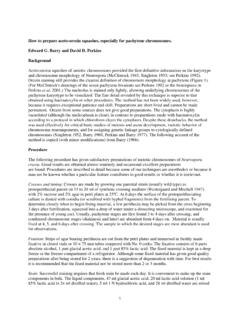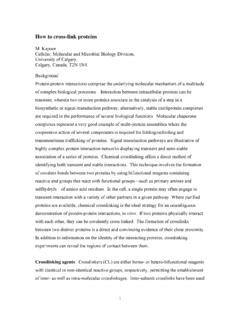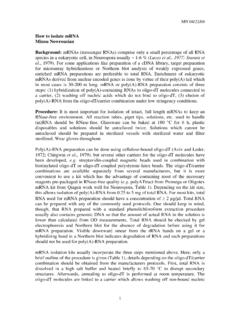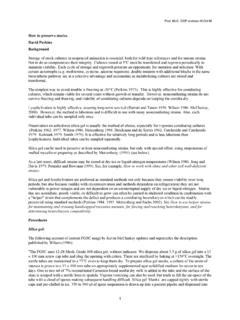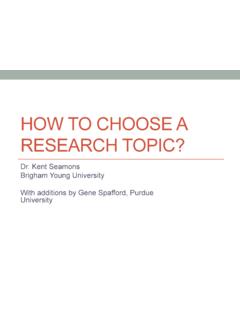Transcription of How to choose and prepare media - Fungal …
1 Last revised 4/18/06 How to choose and prepare media . David D. Perkins Background Two synthetic media are now in general use as standards for culturing and crossing Neurospora -- Medium N (Vogel 1956, 1964) for growth, and Synthetic Cross Medium (SC) (Westergaard and Mitchell 1947) for crosses and mating type tests. Variations of these basic media have been derived to meet special needs. Until 1941, traditional mycological media such as potato dextrose agar and cornmeal agar were used. (See Stevens 1974 for recipes.) Shear and Dodge (1927) employed cornmeal agar both for growing cultures and for making crosses. Cornmeal agar can still be useful as a simple and effective alternative to SC ( , Bennett and Howe 1980). When Beadle and Tatum (1941) required a defined synthetic growth medium ('minimal medium') in their hunt for nutritional mutants, they adopted Fries medium No. 3, which had been devised by the Swedish mycologist Nils Fries (1938) in his studies of Fungal nutrition.
2 (Tatum and Fries had become acquainted while both were postdocs working on microbial growth requirements in K gl's lab in Utrecht.) Fries medium could be made up only at 2 concentration without precipitating. In the Tatum lab, the 2 stock was made up in 50-liter Pyrex carboys fitted with tubing devised to siphon and dispense the sterile medium. After autoclaving, the heavy carboys were lifted onto a high shelf in the laboratory (not without risk of strained backs). Fries medium continued to be used until 1956, when it was replaced by Medium N, which could be made up as a 50 stock, thanks to chelation by citrate. Vogel's Medium N has become the medium of choice when a defined synthetic medium is needed for such applications as routine auxanography, stock-keeping, searching for auxotrophic mutants, or growing Neurospora to prepare DNA, mitochondria, etc. However, another medium ("Bird Medium", Metzenberg 2004) has been designed to supplant medium N for critical applications such as preparing samples for microarrays or analyzing subtle phenotypes of new mutants.
3 Bird medium assures constancy of pH during growth of the culture and circumvents certain other problems that arise in the use of Medium N. It is not meant to supplant Vogel Medium for routine use. In experiments where quantitative precision and reproducibility are important, caution should be exercised regarding batch differences and the purity of chemical constituents. For most purposes, Reagent Grade chemicals are not required, but quality grade should be used. Agar is a natural product, with batches that differ in ability to gel and in their content of minor constituents. It is wise to record Control Numbers. "Complete' media that would satisfy a wide variety of growth requirements were prepared by supplementing minimal medium with hydrolysates and extracts from various unrefined natural sources. Numerous variations have been devised for use in mutant hunts and for culturing auxotrophic strains. No one formula is optimal for all auxotrophs, largely because cross-inhibitions between the constituents mean that strains with certain requirements cannot grow.
4 (Some of the cross-inhibitions are listed below.) Nevertheless, organic media of undefined content have been found that support growth of a wide variety of auxotrophs. Complete media such as those listed below are convenient for growing up multiply mutant stocks and the progeny of crosses segregating for auxotrophic markers. Recipes for commonly used Neurospora media have been compiled in publications such as Davis and de Serres (1970), Bennett and Lasure (1991), and Davis (2000). These are repeated below, together with comments and additional recipes from the literature. In addition to formulas for synthetic media , recipes for three organic 'complete' media are given as examples. 1 Last revised 4/18/06 Recipes GROWTH media 1. Medium N "Vogel's Medium" (Vogel 1956, 1964) Recipe for 1 liter 50 salts: water 755 ml Na3 125 g KH2 PO4250 g NH4NO3100 g H2O 10 g CaCl2.
5 2H2O (dissolved) 5 g trace element solution 5 ml biotin stock solution ml Conveniently prepared in a large Erlenmeyer flask with magnetic stirrer. Dissolve constituents successively. Make certain that everything is dissolved before adding the next component. Moderate heating is useful in speeding solution of the citrate and phosphate. Dissolve the calcium chloride separately in 20 ml water and add the solution slowly. (Alternatively, powdered calcium chloride can be added slowly, but this takes longer.) Add about 5 ml Chloroform as preservative and store the 50 stock solution at room temperature. Single strength Medium N is autoclaved after adding sucrose (1 or ) and, if desired, agar ( ). pH of the single strength medium is about No adjustment is necessary. Grocery-store sucrose is sufficiently pure for most purposes. Trace element solution: In 95 ml. distilled water, dissolve successively with stirring, at room temperature: Citric H2O 5 g ZnSO4,7 H2O 5 g Fe(NH4)2(SO4) H2O 1 g H2O g H2O g H3BO3 (anhydrous) g H2O g Store in a stoppered bottle at room temperature, with 1 ml chloroform added as preservative.
6 The same formula may be used also for other synthetic media . Trivial quantitative differences in published trace element recipes may reflect differences in hydration of the constituents and can be ignored. Biotin stock solution: Dissolve 5 mg biotin in 50 ml water or 50% ethanol. Tube ml aliquots and store at 20 C. Alternatively, a 50% ethanol solution can be stored at 5 C. 2 Last revised 4/18/06 MODIFICATIONS OF MEDIUM N: 2. Medium N without ammonium nitrate (Metzenberg 2003) Recipe for 1 liter of 50 salts: water 770 ml Na3 H2O 130 g KNO3126 g (NH4)H2PO4144 g KH2 PO4 80 g H2O 10 g CaCl2. 2 H2O 5 g trace element solution 5 ml biotin solution, mg/ml ml chloroform to preserve a few ml Because ammonium nitrate in bulk is explosive, obtaining and storing it may be difficult because of safety regulations.
7 This reformulation of Medium N avoids the problem while resulting in a salt solution that is identical with the original. 3. Sorbose/glucose/fructose medium for plating (Brockman and de Serres 1963) Sorbose, which converts spreading wild type mycelial growth into restricted colonies, is toxic in combination with sucrose. Toxicity is overcome, however, if small amounts of glucose and fructose are substituted for sucrose as the carbon source. To medium N, add: sorbose 2% glucose fructose agar Decreasing sorbose to 1% gives less restricted colonies. Colonies are more restricted at 34 C than at 25 C. Glucose at may be used, omitting fructose. Other variations have been used. Medium with fructose becomes somewhat brown when autoclaved, without any obvious detectable effect. If desired, browning can be avoided by autoclaving the sugars separately from the mineral salts and agar, and combining them after autoclaving.
8 Browning is said to be reduced if Synthetic Cross Medium is used rather than Medium N. Depending on the purpose, conidia or ascospores may be distributed on the surface of sorbose agar using a spreader, or they may be suspended in the medium when plates are poured. Alternatively, to obtain colonies at the same level, prelayer with about 10 ml sterile medium, then add as a second layer 5 ml agar containing conidia or ascospores, kept molten at 45 C in a water bath. Addition of a sterile overlayer delays the aerial growth and conidiation that occur when colonies develop on the surface. agar is used for overlayering, 3 to 5 ml per plate. Colonies break through the surface and conidiate much later with 5 ml rather than 3. For details regarding large-scale quantitative platings and for cautions regarding the effect of crowding, see Davis and de Serres (1970). For a protocol using sorbose in combination with the conditional cot-1 mutation, see Catcbeside (1966).
9 3 Last revised 4/18/06 4. Bird medium (Metzenberg 2004) Bird medium is a modification of Vogel medium. Just as amber mutations were named for Harris Bernstein (German for 'amber'), Bird medium was named for Henry Vogel. The following description is taken from Metzenberg's original Fungal Genetics Newsletter account, with a few minor changes in the text (R. L. Metzenberg, personal communication). "This medium was designed to circumvent some problems that arise in the use of Medium N (Vogel 1964). These are, among others, the presence of high levels of citrate, a chelator which leaves the concentration of calcium and trace elements uncertain; the use of ammonium nitrate, which leaves the actual source of nitrogen ambiguous; the use of MgSO4, which does not allow the experimenter to vary the concentration of magnesium and sulfur independently; the high activity coefficient for the pKa values of citrate, which makes the pH unnecessarily sensitive to ionic strength; the use of sucrose, which leaves uncertain the nature and relative amounts of the hexose(s) being used at any particular moment; the need to use chloroform as a preservative, which results in the gradual depletion of the aqueous phase of complexes of trace elements.
10 Molybdate ion is excluded from the trace elements used for Solution 1 because, in concentrated stock solutions, it forms water-insoluble complexes with phosphate plus ammonium ion; instead, it is included in Solution 2. There may still be a light formation of precipitate. If so, it should merely be swirled into suspension before an aliquot is removed for dilution. Finally, concentrations are expressed in moles rather than in grams, which eases the experimenter's task of thinking in terms of stoichiometry and biomass yield. Bird Medium is not meant to supplant Vogel Medium for routine auxanography, stock-keeping, searches for mutants, or growth of Neurospora for preparing DNA, mitochondria, etc. However, it should be seriously considered for critical applications such as preparation of samples for microarrays and analysis of subtle phenotypes of new mutants. Bird Medium supports rapid germination of conidia and rapid growth of mycelium in good yield and with apparently normal morphology.

